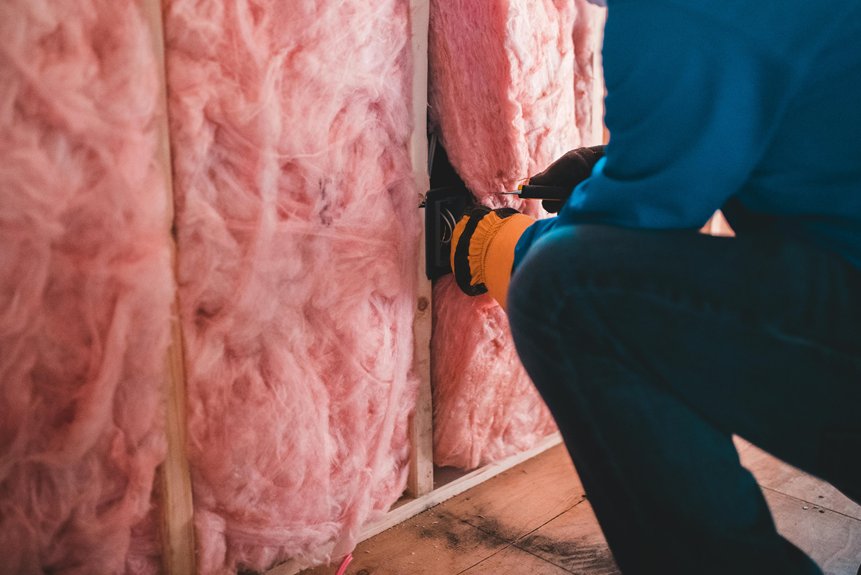White insulation materials encompass a range of options including fiberglass, cellulose, polystyrene, spray foam, and reflective coatings, all designed to enhance energy efficiency. These materials function by reflecting solar heat and minimising heat transfer, which helps to maintain comfortable indoor temperatures and reduce energy costs.
These insulation types can be employed in various parts of a building, such as walls, roofs, foundations, and attics. They offer numerous advantages, including moisture resistance and sustainability.
Having a solid understanding of the different types of insulation and their respective properties can aid in selecting the most suitable option for your needs. For those eager to delve deeper, further information is readily available.
Common Types of White Insulation Materials
White insulation materials are available in several common types, each offering distinct properties tailored to various building requirements.
Fibreglass insulation is highly versatile and frequently found in batts and rolls. It commonly features shades such as white, yellow, or pink, and has a spongy texture. Made from molten glass, it contains 40%-60% recycled glass content, making it an eco-friendly option.
Cellulose insulation, crafted from recycled paper, typically appears grey or beige but can look white once installed. This option is eco-friendly and cost-effective, effectively filling gaps.
Polystyrene insulation is usually whitish and comes in solid or foamed forms, often utilised in rigid panels. DuPont Thermax provides a white finish, valued for its thermal and reflective qualities.
Spray foam insulation is flexible, with colours varying by manufacturer.
These materials offer a diverse array of choices to meet various insulation needs in contemporary buildings across the UK.
Properties and Performance of White Insulation Options
The effectiveness of white insulation options is influenced by various properties that directly impact their performance in building applications. White or light-coloured coatings can reflect a significant portion of sunlight, effectively reducing solar heat gain compared to darker surfaces. High solar reflectance diminishes heat absorption, which can lead to lower cooling costs. Additionally, high thermal emissivity enables the emitted heat to escape, preventing it from transferring indoors. However, the performance of these coatings can be compromised by cleanliness; dirt accumulation can diminish both reflectance and emissivity. Certain coatings, such as Super Therm®, are designed to combine solar reflectance with infrared insulation, which can significantly reduce heat transfer. Performance metrics for these coatings are often not independently verified or accurately documented, raising questions about their actual insulating capabilities. While the reflective properties primarily block visible light, the capabilities of infrared insulation can vary. Insulative paints can provide a slight increase in a surface’s R-value, leading to modest energy savings. Nonetheless, traditional insulation materials, like fiberglass, remain more effective for thermal performance and are generally regarded as the primary solution, with reflective coatings serving mainly as a supplementary option. Understanding these properties is essential for optimising energy efficiency and ensuring effective insulation in buildings across the UK.
Practical Applications of White Insulation in Construction
In construction, white insulation materials are increasingly appreciated for their functional and aesthetic advantages. They find application in various settings, including warehouses, residential buildings, and foundations. For instance, white facer insulation, such as IsoRED MAX WF, combines thermal performance with a finished interior wall, providing both insulation and visual appeal. Lightweight EPS panels are also favoured for exterior systems and refurbishment projects, maintaining thermal resistance while effectively resisting mould. Below-grade EPS boards serve to protect foundations and minimise heat loss. In roofing applications, white EPS panels reflect heat, assist in temperature control, and act as barriers against moisture. Reflective surfaces contribute to energy savings by reducing heat transfer and improving light distribution inside buildings.
| Application Area | Key Benefits | Typical Material |
|---|---|---|
| Warehouses & Industry | Moisture resistance, high thermal performance | IsoRED MAX WF |
| Residential & Commercial | Simple installation, improved air quality | DuraLyte® EPS |
| Foundations & Below-grade | Moisture resistance, thermal efficiency | EPS boards |
| Roof & Attics | Reflective surfaces, durability | EPS panels |
| Structural Panels (SIPs) | Strong, insulating core | Polyiso, EPS |
The growing popularity of white insulation is largely due to its ability to enhance energy efficiency while also contributing to the overall aesthetic of a building. As construction practices continue to evolve, the demand for materials that offer both practicality and visual appeal will likely remain strong.
Benefits and Considerations for Using White Insulation
Using white insulation presents several significant advantages that can enhance a building’s energy efficiency, reduce costs, and lessen its environmental footprint. It reflects a substantial proportion of solar energy, which decreases heat absorption and minimises cooling requirements, particularly in warmer climates. Proper attic insulation significantly reduces overall energy use. This reduction in heat transfer can help avert power outages during hot weather and result in lower energy bills, as less energy is required for heating and cooling.
Moreover, white insulation enhances the efficiency of heating, ventilation, and air conditioning (HVAC) systems, thereby extending their lifespan and potentially saving considerable sums on annual energy costs. Many reflective insulation materials incorporate recycled content, aligning with sustainability objectives.
However, it’s important to consider that white paint primarily reflects visible and ultraviolet light, rather than infrared heat.
Additionally, the benefits of insulation may plateau beyond certain thickness levels. Ensuring proper installation and high-quality materials is crucial for achieving optimal long-term performance.
Conclusion
White insulation materials encompass a broad range of options, each presenting distinct properties tailored to various construction requirements. These materials deliver effective thermal and acoustic insulation, significantly enhancing energy efficiency and comfort within buildings.
When selecting white insulation, it is crucial to take into account factors such as cost, longevity, and suitability for specific applications. Proper selection and installation are essential for ensuring optimal performance, making white insulation a wise choice for numerous building projects.
Gaining a clear understanding of these options empowers individuals to make informed decisions that enhance both functionality and energy savings in their properties.

